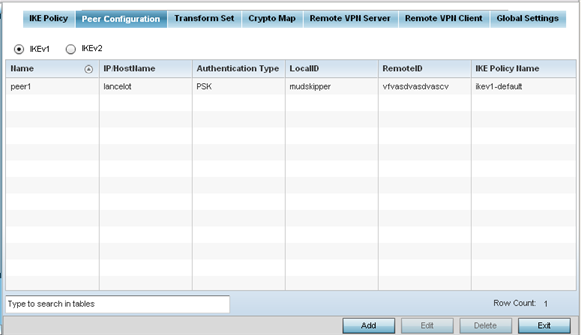Peer Configuration
To define a profile's VPN peer configuration:
-
Go to .
-
Expand Security and select VPN.
-
Select the Peer Configuration tab to assign additional network address and IKE settings to the an intended VPN tunnel peer destination.

-
Select either the IKEv1 or IKEv2 radio button to enforce VPN key exchanges using either IKEv1 or IKEv2.
-
Refer to the following to determine whether a new VPN Peer Configuration requires creation, an existing configuration requires modification or a configuration requires removal.
Name
Lists the 32 character maximum name assigned to each listed peer configuration upon creation.
IP/Hostname
Displays the IP address (or host address FQDN) of the IPSec VPN peer targeted for secure tunnel connection and data transfer.
Authentication Type
Lists whether the peer configuration has been defined to use pre-shared key (PSK) or RSA. Rivest, Shamir, and Adleman (RSA) is an algorithm for public key cryptography. It's the first algorithm known to be suitable for both signing and encryption. If using IKEv2, this screen displays both local and remote authentication, as both ends of the VPN connection require authentication.
LocalID
Lists the local identifier used within this peer configuration for an IKE exchange with the target VPN IPSec peer.
RemoteID
Displays the means the target remote peer is to be identified (string, FQDN etc.) within the VPN tunnel.
IKE Policy Name
Lists the IKEv1 or IKE v2 policy used with each listed peer configuration. If a policy requires creation, select the Create button.
-
Select Add to define a new peer configuration, Edit to modify an existing configuration or Delete to remove an existing peer configuration. The parameters that can be defined for the peer configuration vary depending on whether IKEv1 or IKEv2 was selected



